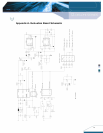
16
Notes on the use of Track function:
1. For proper voltage tracking, first, The ENABLE On/Off pin of the PS2 module is lef
t
unconnected (or tied to GND for negative logic modules or tied to VIN for positive logic
modules), so that the modules are ON by default and second applied input voltage to the
PS1 and PS2. The TRACK pin is held at ground potential for duration of input voltage
reaches its minimum input voltage (VIN,min) and then held for at least 10mS thereafter.
This brief period gives the modules time to complete their internal soft-start initialization.
2. The PS2 output will not follow the PS1 voltage until the PS2 has completed its soft-star
t
time. After this time, PS2 is capable of both sinking and sourcing current when following
the voltage at the TRACK pin.
3. Notice that power down by removing the input voltage may not provide proper powe
r
tracking below under voltage lockout limit where the both integrated switches are off. So,
using the ENABLE On/Off signal of PS1 for power down is the preferred option for powe
r
tracking.
4. The TRACK pin absolute maximum voltage cannot over the Vin.
5. For type A: When Tracking is unused, put R1 equal to 1KΩ and connect TRACK pin to
+Vcc
For type C: When Tracking is unused, put R1 equal to 30.1KΩ and connect TRACK pin to
+Vcc
Test
1) Put R56 to take the place of R1 on the POL evaluation board by use the value from above
equation for different tracking purpose.
2) Use channel 1 and channel 2 measures the output voltage of PS1 and PS2.
3) Prepare turn on, disable remote On/Off of the PS1, enable remote On/off of the PS2, and
supply input voltage to PS1 and PS2.
4) For the power on, enable switch on of PS1. In the meantime, to track power up by scope
trigger function.
5) For the power down, enable switch off of PS1 to track power down.
6) Illustration of tacking features can be found in the section of Detailed Description.
8.3 Dynamic Characteristics
8.3.1 Output Voltage Deviation
Output Voltage Deviation is defined as the response of the converter to a sudden step change
in the output load current. The output voltage deviation is characterized by two parameters:
Maximum Output Voltage Deviation and Response Time (please refer to the data sheet for the
detailed specification). The value of dynamic resistance for a defined step current is defined
as:
Imax
Vout
R
dynamic
*5.0
=


















